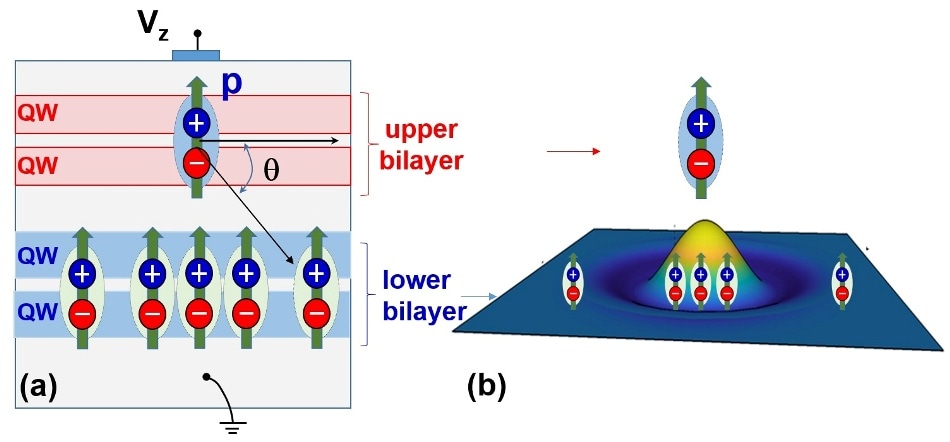May 13 2019
For the first time, direction-dependent and strong interactions in quantum liquids of excitons have been realized by an international collaboration including European, Israeli, and US researchers. These interactions are in contrast with the spatial isotropy of the link between charged particles.
 Interaction between excitonic dipoles: (a) excitons in stacked bilayers consisting of GaAs quantum wells (QWs); (b) excitons in the upper bilayer induce, via the attractive inter-bilayer excitonic interaction, exciton accumulation in the lower bilayer. (Image credit: Forschungsverbund Berlin e. V.)
Interaction between excitonic dipoles: (a) excitons in stacked bilayers consisting of GaAs quantum wells (QWs); (b) excitons in the upper bilayer induce, via the attractive inter-bilayer excitonic interaction, exciton accumulation in the lower bilayer. (Image credit: Forschungsverbund Berlin e. V.)
This spatial anisotropy has an impact on the way particles arrange themselves in space and paves the way for the artificial creation of exotic states of matter. The study outcomes were reported in Physical Review X.
The old saying “Birds of a feather flock together” might be applicable to various life circumstances. However, it surely is not applicable to electric charges: charges of opposite polarity attract each other, while charges of same polarity always repel each other. One result of the attraction between unlike charges is the generation of excitons (electron-hole pairs) in semiconductors.
It is possible to create such pairs of positively charged holes and negatively charged electrons through the absorption of light quanta (photons). Excitons are purported quasi-particles that are the consequence of the bonding of a hole and an electron by the attractive electrostatic Coulomb interaction between them.
Although excitons are mobile they are not stable as the holes and electrons can rapidly recombine, resulting in photon emission. However, it is feasible to create long-living excitons in exclusive semiconductor bilayers that comprise of two closely spaced quantum wells isolated by a thin potential barrier.
Upon applying a bias voltage to the structure, the holes and electrons forming the exciton will be stored in separate quantum wells: this charge separation considerably increases the recombination lifetime. The long-living excitons obtain a dipole moment p and are hence called dipolar, or indirect, excitons.
Not just the excitons but also the dipolar excitons are neutral particles externally and the riddle is how dipolar excitons interact with each other. The solution to this riddle can be found by regarding them to be aligned dipoles.
In contrast to the electrostatic Coulomb interaction between two charges, which is only dependent on the distance between them, the interaction between two dipoles is dependent not only on the relative orientation between them but also on the vector that connects them. In the case of aligned dipoles such as the dipolar excitons, the interaction varies from repulsive to attractive with the increase in the angle from 0° to 90°.
In experiments conducted on dipolar excitons to date, excitons were used in a single bilayer, with which one can only investigate the dipolar interaction’s repulsive component. Currently, an international research team including scientists from Paul-Drude-Institut für Festkörperelektronik in Berlin, the Hebrew University of Jerusalem, the Institute of Science and Technology Austria, and the University of Princeton discovered a smart method to address the difficulties faced by stacking two dipolar layers: this enabled them to show for the first time the attractive dipole-dipole component of the coupling between the particles, with astonishing outcomes. They demonstrated that the existence of dipolar excitons in one bilayer causes an accumulation of dipolar excitons in the other bilayer. The latter confirms that under suitable conditions, the old proverb could also be applicable to dipolar excitons.
In the recent past, dipolar quantum liquids and gases gained considerable attention as they host a large amount of exotic multi-particle phenomena that originate in the long-range and anisotropic character of the dipole-dipole interactions. To date, dipolar phases of matter have been largely analyzed against the backdrop of ultracold gases of magnetic atoms and polar molecules: one fine example is the recently noticed supersolidity—crystals in which the atoms flow without any friction. However, low-density ensembles such as these render it difficult to realize the regime of strong interparticle interactions in which a majority of the exotic physics occur.
The strong attractive inter-bilayer attractive coupling currently shown by Hubert and colleagues renders it possible to analyze these phenomena in a solid-state system of dipolar fluids. Specifically, it can investigate interaction strengths and dipolar densities that are unavailable in atomic realizations at present. This is anticipated to unravel new collective effects and phases. One good example is the larger than anticipated mutual drag and binding energies between dipolar particles observed in the exciton experiments.
This breathtaking effect is due to the occurrence of electro-acoustic waves or polarons in the two fluids, adjudicated by the isolated dipole-dipole interactions. With an increase in fluid density, there is a considerable change in the polaron energy, probably depicting the phase boundary between liquid and gas states. This remarkable phenomenon proves to be a good encouragement for future experiments aimed at realizing exotic multi-body phases with anisotropic interactions of powerfully correlated quantum systems.